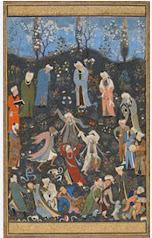About sindh
Sindh is a province located in the southeastern part of Pakistan. It is known for its rich and diverse cultural heritage, which is influenced by various historical and regional factors. The Sindhi culture has evolved over centuries and encompasses various aspects such as language, traditions, festivals, music, dance, arts, cuisine, and attire. Here are some key features of the Sindhi culture.
Traditions and Festivals: Sindhi people have a strong attachment to their cultural traditions and religious festivals. Some of the prominent festivals celebrated in Sindh include Eid-ul-Fitr, Eid-ul-Adha, Muharram, Diwali, and Urs of various Sufi saints. These festivals are marked by vibrant celebrations, music, dance, and traditional rituals.
Music and Dance: Music plays a significant role in Sindhi culture. The traditional musical instruments, such as the Sindhi Sarangi, been, and ektara, are used to create melodious tunes. Sindhi folk music, known as "Lada," is popular and often accompanied by traditional dance forms like Dhamal and Jhumar.
Arts and Crafts: Sindh has a rich tradition of arts and crafts. Ajrak, a unique block-printed textile, is an iconic symbol of Sindhi culture. Other crafts include ralli (colorful quilts), kashi work (embroidery), lacquer work, pottery, and mirror work. These crafts showcase the craftsmanship and creativity of the Sindhi people.
Cuisine: Sindhi cuisine is known for its flavorsome and spicy dishes. Traditional Sindhi food includes dishes like Sindhi Biryani, Sai Bhaji, Sindhi Curry, Sindhi Pulao, and Kebabs. Sai Bhaji, made from spinach and lentils, is a staple dish in Sindhi households.
Attire: The traditional attire of Sindhi men includes a long shirt called "Kameez" or "Jama," which is paired with loose-fitting trousers called "Suthan." Sindhi women traditionally wear a flowing dress called "Lehenga" or "Ghagra," along with a blouse and a colorful dupatta.
Sufi Influence: Sindh has a rich Sufi heritage, and the teachings of Sufi saints have had a profound impact on Sindhi culture. The Sufi shrines in Sindh, such as the Shrine of Shah Abdul Latif Bhittai and the Shrine of Lal Shahbaz Qalandar, are important pilgrimage sites and centers of spiritual devotion.
Overall, Sindhi culture is characterized by its vibrant traditions, warm hospitality, and deep-rooted connection to its history and heritage. It continues to thrive and evolve, showcasing the resilience and creativity of the Sindhi people.
Education: Education holds significant importance in Sindhi culture. Sindh has been home to renowned educational institutions throughout history, including the ancient University of Sindh at Makli. Today, there are numerous schools, colleges, and universities in Sindh that contribute to the educational development of the region.
Overall, Sindhi culture is characterized by its vibrant traditions, warm hospitality, and deep-rooted connection to its history and heritage. It continues to thrive and evolve, showcasing the resilience and creativity of the Sindhi people.
Certainly! Here are some additional aspects of Sindhi culture:
Literature: Sindhi literature has a rich history that dates back to ancient times. The famous Sufi poet Shah Abdul Latif Bhittai is considered the greatest literary figure in Sindhi culture. His poetry, collected in the Shah Jo Risalo, reflects the cultural and spiritual values of the region. Sindhi literature also includes folk tales, proverbs, and epic poetry.Education: Education holds significant importance in Sindhi culture. Sindh has been home to renowned educational institutions throughout history, including the ancient University of Sindh at Makli. Today, there are numerous schools, colleges, and universities in Sindh that contribute to the educational development of the region.
Sports: Sindhi culture has a love for sports, particularly wrestling and horse racing. Traditional Sindhi wrestling, known as "Malakhra," is a popular sport that showcases strength and agility. Horse racing events, known as "Sindh Festival," attract participants and spectators from all over the province.
Architecture: The architecture of Sindh reflects a blend of various influences, including ancient Indus Valley Civilization, Islamic, and colonial periods. Historical landmarks such as the Makli Necropolis, Mohenjo-daro (a UNESCO World Heritage site), and various forts and palaces showcase the architectural brilliance of the region.
Cultural Festivals: In addition to religious festivals, Sindhi culture celebrates various cultural festivals. Sindhi Topi Day is observed on December 4th each year, where people wear the traditional Sindhi cap called "Sindhi Topi" to promote cultural unity and pride. Sindhi Cultural Day, observed on the first Sunday of December, is a grand celebration of Sindhi culture, with musical performances, exhibitions, and cultural activities.
Social Values: Sindhi culture places emphasis on strong family values, respect for elders, and hospitality. Families are considered the cornerstone of society, and close-knit family ties are highly valued. Hospitality is deeply ingrained in Sindhi culture, and guests are warmly welcomed and treated with utmost respect and generosity.
Economic Activities: Agriculture is the backbone of the Sindhi economy. The fertile lands of the Indus River support the cultivation of crops such as wheat, rice, cotton, and sugarcane. Sindh is also known for its traditional crafts, including handwoven textiles, pottery, and handicrafts, which contribute to the local economy.
- These aspects collectively shape the vibrant and diverse Sindhi culture, which is deeply rooted in its history, traditions, and values. It is a testament to the rich cultural tapestry of the region and the resilience of its people.

.jpeg)














Comments
Post a Comment